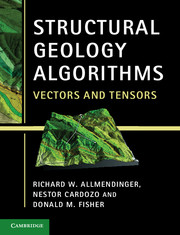Book contents
- Frontmatter
- Contents
- Preface
- Chapter One Problem solving in structural geology
- Chapter Two Coordinate systems, scalars, and vectors
- Chapter Three Transformations of coordinate axes and vectors
- Chapter Four Matrix operations and indicial notation
- Chapter Five Tensors
- Chapter Six Stress
- Chapter Seven Introduction to deformation
- Chapter Eight Infinitesimal strain
- Chapter Nine Finite strain
- Chapter Ten Progressive strain histories and kinematics
- Chapter Eleven Velocity description of deformation
- Chapter Twelve Error analysis
- References
- Index
Chapter Eleven - Velocity description of deformation
Published online by Cambridge University Press: 05 June 2012
- Frontmatter
- Contents
- Preface
- Chapter One Problem solving in structural geology
- Chapter Two Coordinate systems, scalars, and vectors
- Chapter Three Transformations of coordinate axes and vectors
- Chapter Four Matrix operations and indicial notation
- Chapter Five Tensors
- Chapter Six Stress
- Chapter Seven Introduction to deformation
- Chapter Eight Infinitesimal strain
- Chapter Nine Finite strain
- Chapter Ten Progressive strain histories and kinematics
- Chapter Eleven Velocity description of deformation
- Chapter Twelve Error analysis
- References
- Index
Summary
Introduction
There are almost as many types of models as there are reasons for constructing them. At one extreme, a qualitative interpretation of the history of a region may be described as a “model.” We have all seen titles like: “A Tectonic model for the Little Jackass Creek Quadrangle.” At the other extreme, full-fledged mechanical models incorporate a complete set of constitutive relationships in a computational or analytical framework. In this chapter, we present one type of numerical model that falls between these two extremes. It is based on a limited set of largely kinematic and geometric assumptions, while ignoring forces, rock properties, equations of equilibrium, constitutive relationships, etc. The purpose of these kinematic models is to simulate structural geometries and visualize the evolution of structures through time. Because they can be executed quickly, kinematic models can be run thousands or millions of times to test large parameter spaces. Do not fall into the trap, however, of thinking that they “explain” the deformation!
Kinematic modeling uses ad-hoc velocity fields that satisfy known boundary conditions, and obey reasonable assumptions such as conservation of mass throughout deformation. Strictly speaking, the velocity fields used have no mechanical or dynamical significance. They are just convenient models to simulate observed structures from a descriptive (i.e., in terms of strain) rather than a genetic (i.e., in terms of stress) manner (Marrett and Peacock, 1999). A discussion of the advantages and disadvantages of kinematic with respect to mechanical modeling is beyond the scope of this book. The interested reader can consult Marrett and Peacock (1999), and Pollard (2000).
Information
- Type
- Chapter
- Information
- Structural Geology AlgorithmsVectors and Tensors, pp. 217 - 253Publisher: Cambridge University PressPrint publication year: 2011
